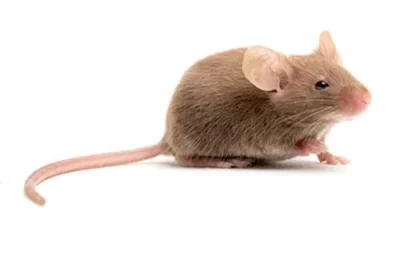Latin Name: Mus musculus

The house mouse is a common rodent in the home with origins from India and Southeast Asia. They disturb the home and pose a threat to man’s health and property. They breed rapidly and adapt quickly to changing situations. For instance, the female mouse gets pregnant seven times every year and gives birth to a litter of 6 – 8 pups on average.
They are small with a furry round body, pointed nose, long hairless tails, and large ears. There are several species, i.e., the field mice, wood mice, spiny mice, zebra mice, etc.
You can find mice anywhere irrespective of the climate and environment in both empty buildings and homes. They are mostly about 12 to 20 cm in length, including their tail, and weigh approximately 0.5 to 1 ounce. They have multiple color variations, i.e., light brown to black, grey, and white. They have pointed noses, small eyes, large ears, and hairless tails. They have four legs. Also, their snorts are usually triangular with long whiskers.
House mice are nocturnal primarily. They are quick to escape from dangerous situations. They love to stay close to their hideout and rarely travel more than 100 feet from it.
Mice prefer to live around humans, but you will also find them in fields and woods. They sometimes stray far from buildings and are most likely to infest urban areas. When the weather is cool, they seek shelter in homes, storage sheds, and barns. You can also find them in bushy places, woodlands, and prairies. They love to burrow underground when they are in the wild. These burrows protect them from their predators like cats, birds, foxes, and wild dogs.
Survey has shown that white-footed mice are the most abundant rodents in the mixed hardwood forests in the eastern part of the country. They also like to have a large area for themselves only.
They store their food in their nest or burrow and feed as omnivores. In a wild, non-domestic situation, you will find them eating plant leaves, roots, fruits, seeds, berries, and insects. Whenever you see them around humans, they eat anything available to them. They have a voracious appetite eating like 15 to 20 times per day such that if there’s no food in the house, they could eat each other. They also eat cereals, nuts, and grain-based products.
The appearance of a mouse in the home indicates a large population. Since adult mice love to occupy the more protected areas, the little mice are left to run around the house.
You will also find mice droppings around where mice live, stop eating, collect food, and travel. Their droppings are usually 1/8 – ¼ inch long, rod shape, and pointed at both ends. In the presence of any droppings, you should remove and reinspect for the mouse, but use respiratory protection as you do this.
Another sign of an infestation is footprints and tracks left in dusty locations. Their tracks are usually 4-toes prints with their front feet and 5-toed prints with the hind feet. Aside from these footprints, mouse nest builders hence seeing nests in burrows indicate mice activity.
Mice like to chew on items in their habitat; hence, nibbled debris like pieces of plastic, paper, bits of wood, and gnaw marks along the edges of timber indicate the presence of mice.
You can recognize mice by the noise they make running from one place to another or scratching walls and attics. Odors from dead mice or their urine and feces are unpleasant indicators of mice infestation.
Mice are popular for gnawing objects, contaminating stored food, and transmitting disease with their droppings, bites, urine, and explicit content with fleas, mites, and cats. They also gnaw on wires and wood such that they make costly fire hazards and repairs. In kitchens and pantries, mice contaminate human food with their fur and droppings.
If you want to prevent mice from entering your home, seal all cracks, crevices, gaps, holes with cement, or any mixing compound. Do not use wood to fill these holes because mice are capable of chewing those surfaces.
Another way to prevent the infestations of the mouse is by cleaning the house. Clean your dishes after use and store your food in metal and glass containers with tight lids. Mice prefer scavenged food particles, so removing all crumbs or morsels on floors and tabletops is an excellent thing to do.
Install door sweeps and repair damaged screens. Also, ensure to screen vents and openings to chimneys. Also, eliminate all moisture sites, including clogged drains and leaking pipes, serving as perfect breeding sites for pests. Ensure you also store any firewood around the house at least 20 feet away from home and keep trees trimmed and cut back.
If you suspect these pests are in or around your home, give us a call for a Free Home Inspection!
